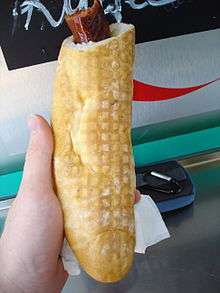Hot dog bun
A hot dog bun is a type of soft bun shaped specifically to contain a hot dog or another type of sausage. The bun allows eaters consume hot dogs without burning their hands.[1]
 A hot dog bun of the side-loading variety containing a hot dog sausage dressed with three common condiments: ketchup, relish, and mustard | |
| Alternative names | Side-loading bun |
|---|---|
| Type | Bun |
| Place of origin | United States |
| Main ingredients | Flour, water |
| Variations | New England-style hot dog bun |
The side-loading bun is common in most of the United States, while the top-loading New England-style hot dog bun is popular in that region.[2] Other regional variations include the addition of poppy seeds to the buns of Chicago-style hot dogs.
History
Hot dog historian and professor emeritus at Roosevelt University Bruce Kraig believes the term "hot dog" was invented in the late 19th century by American observers of German immigrants, who ate sausages on buns. The Americans joked that the sausages looked suspiciously like the Germans' dachshunds.[3]
Charles Feltman invented an elongated hot dog bun on Coney Island in 1871 according to writer Jefferey Stanton.[4]
At the 1904 Louisiana Purchase Exposition, in St. Louis, Missouri, a German concessionaire, Antoine Feuchtwanger, served hot sausages called 'frankfurters', after his birthplace, Frankfurt, in Hesse.[5][6] At first he loaned gloves for his customers to hold his sausages. When many were not returned, he asked his brother, who was a baker, to invent a solution. Thus, the hot dog bun was born.[7]
Regional variations
Split-top hot dog buns are popular in New England for lobster rolls and clam sandwiches.
In Chicago, Illinois, where poppy-seed buns are popularly served with Chicago-style hot dogs, the buns are made with high-gluten flour to hold up to steaming.[8]
In Austria, Poland, and throughout Central Europe a "hot dog" is a baguette which is hollowed out by cutting off the end and impaling it on a spike so a sausage can be inserted. In Denmark this variation is known as a "French Hot Dog" because of the use of baguette, and a "French Hot Dog Dressing" which contains Dijon Mustard. Specially prepared baguettes are made for this popular food.

See also
- New England-style hot dog bun
- List of buns

References
- "The Evolution of Hot Dogs", May 8, 2003 accessed January 29, 2011.
- "New England-style bun, from HoJo’s to homemade", July 2, 2013 accessed February 12, 2014.
- National Hot Dog and Sausage Council. "Archived copy". Archived from the original on 2012-01-03. Retrieved 2012-01-02.CS1 maint: archived copy as title (link) "Straight From The "H" Files: The Hot Dog's True History"], accessed January 29, 2011
- Josh Chetwynd in "How the Hot Dog Found Its Bun: Accidental Discoveries and Unexpected Inspirations that shape what we Eat and Drink, 2012.
- Allen, Beth; Westmoreland, Susan (ed.) (2004). Good Housekeeping Great American Classics Cookbook. New York: Hearst Books. p. 49.
- Snodgrass, Mary Ellen (2004). Encyclopedia of Kitchen History. New York: Fitzroy Dearborn. p. 968.
- "History of the Hot Dog", accessed January 29, 2011. Archived September 26, 2010, at the Wayback Machine
- Zeldes, Leah A. (2010-07-13). "It takes big buns to hold Chicago hot dogs". Dining Chicago. Chicago's Restaurant & Entertainment Guide, Inc. Retrieved 2010-07-31.